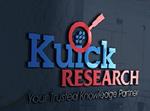Delhi, May 15, 2025 (GLOBE NEWSWIRE) -- US Orphan Designated Drugs Market Opportunity, Drugs Sales, Price, Dosage and Clinical Trials Insight 2030 Report Offering and Highlights:
- US Orphan Designated Drugs Market Opportunity: > US$ 190 Billion By 2030
- Insight On FDA Designated Orphan Drugs In Clinical Trials: > 850 Orphan Drugs
- Clinical Trials Insight By Company, Indication, Phase and Priority Status
- Insight On FDA Designated Marketed Orphan Drugs: > 500 Orphan Drugs
- Pricing and Dosage Insight: > 400 Marketed Orphan Drugs
- US, Global, Regional, Annual Sales Insight (2019 – Q1’2025): >150 Orphan Drugs
- Sales, Price and Dosage Data Represented In More Than 1000 Charts and Tables
- Orphan Designation Insight By Indication, Company, Trial Phase, Marketed Drugs Represented In 1000 Tables
Download US Orphan Designated Drugs Market Opportunity, Drugs Sales, Price, Dosage and Clinical Trials Insight 2030 Report:
https://www.kuickresearch.com/report-fda-orphan-drug-database
The US orphan market for rare cancers is a specialized oncology frontier that has seen tremendous development over the last decade. Each of these rare cancers, which individually affect fewer than 200,000 Americans, collectively affect millions of patients and their families and pose unique therapeutic challenges. Traditionally underserved with scant commercial interest, rare cancer therapies are now a center of innovation, with around 50% of all orphan drug designations aimed at oncology conditions. This niche market has expanded to a very lucrative segment, with scientific progress fueling clinical progress and commercial opportunity alike.
Rare cancer therapies illustrate the potential for focused strategies to transform patient care. Bristol Myers Squibb's Opdivo (nivolumab), originally approved for rare types of Hodgkin lymphoma, is the successful development track many orphan oncology drugs take. Initially approved for restricted indications in small patient populations, Opdivo eventually gained approval for more extensive uses, revolutionizing treatment paradigms in several types of cancer. This strategy for development, targeted at defined patient populations, has become increasingly common, enabling firms to validate clinical proof-of-concept before expanding use.
Precision medicine revolutionized the rare cancer space by making it possible to segment ordinary cancers into rare subtypes through molecular segmentation. Bayer's Vitrakvi (larotrectinib) is a prime example of this strategy, treating rare TRK fusion-positive cancers in several types of tumors instead of targeting common anatomical classes. This tissue-agnostic approval process has reframed the way that rare cancers are imagined, opening up possibilities for therapies focused on particular genetic mutations that occur in small groups of patients across many types of cancer. So, too, does Roche's Rozlytrek (entrectinib) target ROS1-positive non-small cell lung cancer, a rare molecular subgroup that occurs in about 2% of lung cancer patients.
Outside of conventional pharma, the rare cancer segment has welcomed next-generation therapeutic modalities. Kymriah (tisagenlecleucel), Novartis's CAR-T cell therapy for rare B-cell cancers, illustrates how cellular therapies have gained early use in rare cancer indications where unmet need warrants novel approaches. This pattern carries over to antibody-drug conjugates such as Pfizer's Adcetris (brentuximab vedotin) for Hodgkin lymphoma and systemic anaplastic large cell lymphoma, marrying targeted delivery mechanisms with highly active cytotoxic agents to achieve maximum efficacy while limiting systemic toxicity.
The orphan cancer drug environment for rare malignancies has enabled specialist development firms dedicated entirely to underrepresented cancers. Epizyme (acquired by Ipsen) developed its clinical pipeline from rare epigenetic cancer targets and gained approval for Tazverik (tazemetostat) in epithelioid sarcoma and follicular lymphoma. In the same vein, Y-mAbs Therapeutics has also focused on rare pediatric malignancies, with the development of Danyelza (naxitamab) for neuroblastoma, which occurs in about 700 children per year in the US.
Collaborative models have gained prominence in rare cancer drug development. The Rare Cancer Research Foundation has organized tissue donation programs and research networks that link patients with scientists who are working on developing targeted therapies. Likewise, the TARGET pediatric cancer program has expedited molecular characterization of rare childhood cancers, generating publicly available datasets that guide drug development across the industry. These collaborative strategies overcome the inherent difficulties of creating treatments for diseases where patient populations are geographically remote and clinical trial recruitment is challenging.
In the future, the rare cancer orphan drug market in the US is expected to evolve to develop with new technologies, such as artificial intelligence driving drug discovery and development. Machine learning computations are assisting the identification of new targets in uncommon cancers by studying intricate molecular datasets, and electronic platforms bring highly scattered patients in touch with the right clinical trials. These technological advances, together with growing biological insights into the drivers of rare cancers, predict the orphan oncology space as a vibrant domain for scientific breakthrough and therapeutic progress, bringing patients new hope that has long eluded them.

Neeraj Chawla Research Head Kuick Research neeraj@kuickresearch.com https://www.kuickresearch.com

